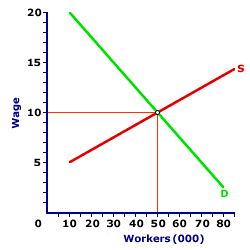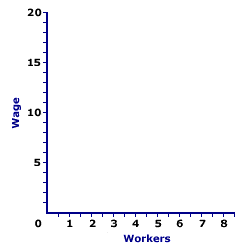
|
|
MATURITY STAGE: The third stage in the product life cycle, characterized by flattening of sales and decreasing profit margins. Advertising and promotion are used to maintain market share and to prevent the erosion of sales and profits. During this stage, the initial decline of a product begins and many businesses try to "re-invent" their products to prevent the upcoming decline stage. Many times the company finds new uses for an existing product (baking soda as a deodorizer), totally new markets (foreign countries), or a way to enhance the existing product to make it better and to re-start the life cycle. The television has gone through at least two life cycles, first from black and white to color and then from color to high definition (HD) and plasma. Along the way there were enhancements such as remote control, VCRs to complement them, and cable to help with reception.
Visit the GLOSS*arama
|
|


|

|
                           PERFECT COMPETITION, FACTOR MARKET ANALYSIS: The analysis of a factor market characterized by perfect competition indicates that each buyer maximizes profit by equating marginal revenue product to the factor price. This achieves an efficient allocation of resources and provides a benchmark for analyzing other factor market structures, including monopsony, monopoly, and bilateral monopoly. Perfect competition is characterized by a large number of relatively small firms, identical products, freedom of entry and exit, and perfect knowledge. These characteristics mean that each firm is a price taker with no market control. Perfect competition is most commonly analyzed in terms of output or product markets in which business firms are the producers and household consumers are the buyers. However, perfect competition also can be used to analyze resource or factor markets, in which business firms are the buyers and household factor owners are the sellers.When perfect competition is applied to a factor market, the primary difference is that the large number of relatively small firms are doing the buying rather than the selling. And the identical product that is being bought is a factor of production rather than a consumption good. Moreover, realism, idealism, and efficiency are just as important for perfect competition in factor markets as they are for perfect competition in product markets. In other words, a perfectly competitive factor market is an ideal model of economic efficiency at its best, which does not exist in the real world in its pure form. A perfectly competitive factor market is best used as a benchmark for comparison with real world factor markets, including monopsony (a market control by a single buyer), monopoly (a market control by a single seller), and bilateral monopoly (a market with a single buyer and a single seller). Competitive Market EquilibriumAn example that can be used to illustrate a perfectly competitive factor market is provided by the hypothetical factor market for food preparation workers, such as those who might work for Waldo's TexMex Taco World to produce Shady Valley's most popular sour-cream-and-jalapeno-pepper-based meal, Super Deluxe TexMex Gargantuan Tacos. Shady Valley contains a large pool of workers who can perform this productive task. Moreover, these workers are also suitable for employment in a wide range of other productive activities. A large number of relatively small firms in Shady Valley, in addition to Waldo's TexMex Taco World, are on the buying side of this factor market.| Competitive Labor Market |  |
As such, Waldo's Taco World is a price taker when it comes to hiring workers. Waldo can hire as many workers as it needs at the going factor market price, so there is no reason to pay more. And competition prevents Waldo from paying workers less than the going price. Waldo pays the going price.This diagram displays Shady Valley's factor market for the type of workers who are employed by Waldo's Taco World. With the positively-sloped supply curve and the negatively-sloped demand curve, it looks just as might be expected for a perfectly competitive factor market. The vertical axis measures the hourly wage rate paid the workers and the horizontal axis measures the number of workers. As a perfectly competitive market, the intersection of the demand and supply curves is the market equilibrium. This occurs with a $10 wage and 50,000 workers. Most important to employers like Waldo's TexMex Taco World is the $10 wage. Waldo is able hire as many workers as it wants at this $10 wage. The question is: How many workers is Waldo willing and able to hire? Waldo's Cost and RevenueTo answer this question, two bits of information are needed. One is marginal factor cost. The other is marginal revenue product',500,400)">marginal revenue product. Like any good profit-maximizing firm, Waldo makes decisions based on the equality of marginal cost and marginal revenue. When producing tacos, Waldo produces the quantity that equates marginal cost and marginal revenue. He makes a similar decision when hiring workers. However, rather than the marginal cost of production and the marginal revenue from selling the production, Waldo is concerned with the marginal cost and marginal revenue of employing workers, which go by the terms marginal factor cost and marginal revenue product, respectively.| Waldo's Taco Employment |  |
- Marginal Factor Cost: Click the [Marginal Factor Cost] button to reveal Waldo's marginal factor cost from employing taco-making workers labeled S=MFC. The label indicates that this is the marginal factor cost of hiring labor AND the labor supply curve facing Waldo's Taco World. Note a couple of things about the diagram and curve.
First, while the vertical axis measure the factor price comparable to that for the overall Shady Valley labor market, the horizontal quantity changes from measuring thousands of workers to measuring only a handful of workers. The reason for this change is that Waldo is only a very small fraction of the overall market.
Second, the curve labeled S=MFC is horizontal at the $10 wage. This is, in fact, Waldo's marginal factor cost of employing workers. Each extra worker hired by Waldo increases total factor cost by exactly $10. This curve is also Waldo's average factor cost curve and the factor supply curve that it faces for hiring workers.
- Marginal Revenue Product: The other half of Waldo's profit-maximizing decision is marginal revenue product. Marginal revenue product indicates the change in revenue resulting from hiring one additional worker. A click of the [Marginal Revenue Product] button reveals Waldo's marginal revenue product curve, labeled MRP. This curve is negatively-sloped because marginal revenue product is based on marginal physical product which declines with extra employment due to of the law of diminishing marginal returns. Because each additional worker is less productive, each additional worker generates less extra revenue.
Profit Maximizing EmploymentAll of the information needed to identify the quantity of workers that maximizes Waldo's profit is in hand. The profit-maximizing employment is the quantity that equates marginal factor cost and marginal revenue product, which is the intersection of the MFC and MRP curves. Click the [Profit Max] button to highlight this quantity. The profit-maximizing quantity of employment is 5 workers with each worker paid the going factor market price of $10 per hour.Why is this profit maximization? - Should Waldo hire fewer than 10 workers, then marginal revenue product is greater than marginal factor cost. An extra worker contributes more to revenue that it adds to cost. This increases Waldo's profit. Waldo should hire any worker with a marginal revenue product that exceeds marginal factor cost.
- Should Waldo hire more than 10 workers, then marginal revenue product is less than marginal factor cost. An extra worker contributes less to revenue that it adds to cost. This decreases Waldo's profit. Waldo should fire any worker with a marginal revenue product that is less than marginal factor cost.
- Should Waldo hire exactly 10 workers, then marginal revenue product is equal to marginal factor cost. An extra worker contributes as much to revenue as to cost. This keeps Waldo's profit constant. Waldo should hire the worker with a marginal revenue product equal to marginal factor cost, but no more.
EfficiencyNot only does the equality between marginal factor cost and marginal revenue product maximize Waldo's profit, it also generates an efficient use of resources. This results because marginal factor cost is equal to the factor price. Not only is marginal revenue product is equal to marginal factor cost, it is also equal to the factor price. Why is the equality between marginal revenue product and factor price efficient? Marginal revenue product is the value of the good produced. Factor price is the opportunity cost of production, the value of goods not produced. - If marginal revenue product is greater than factor price, then the value of the good produced is greater than the value of goods not produced. Society can generate more overall satisfaction by producing more of the good.
- If marginal revenue product is less than factor price, then the value of the good produced is less than the value of goods not produced. Society can generate more overall satisfaction by producing less of the good.
- If marginal revenue product is equal to factor price, then the value of the good produced is equal to the value of goods not produced. Society cannot generate more overall satisfaction by producing more or less of the good.
Because profit maximization means marginal revenue product is equal to marginal factor cost, it is also equal to factor price for perfect competition. The equality between factor price and marginal revenue product is the signal for efficiency.

Recommended Citation:PERFECT COMPETITION, FACTOR MARKET ANALYSIS, AmosWEB Encyclonomic WEB*pedia, http://www.AmosWEB.com, AmosWEB LLC, 2000-2025. [Accessed: June 30, 2025].
Check Out These Related Terms... | | | | |
Or For A Little Background... | | | | | | | | | |
And For Further Study... | | | | | |
Search Again?
Back to the WEB*pedia
|



|

|
|
Francis Bacon (1561-1626), a champion of the scientific method, died when he caught a severe cold while attempting to preserve a chicken by filling it with snow.
|

|
|
"I learned about the strength you can get from a close family life. I learned to keep going, even in bad times. I learned not to despair, even when my world was falling apart. I learned that there are no free lunches. And I learned the value of hard work. " -- Lee Iacocca
|

|
BIF
Bank Insurance Fund
|

|
|
Tell us what you think about AmosWEB. Like what you see? Have suggestions for improvements? Let us know. Click the User Feedback link.
User Feedback
|


|


